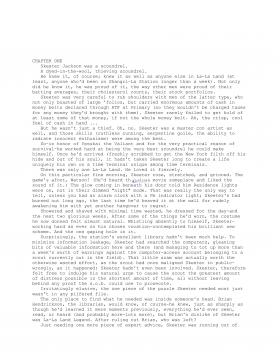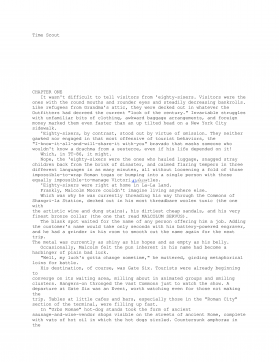Swanwick, Michael - Bones of the Earth
VIP免费
2024-11-30
1
0
475.83KB
178 页
5.9玖币
侵权投诉
Michael Swanwick - Bones of the Earth
BONES OF THE EARTH
by MICHAEL SWANWICK (2002)
[VERSION 1.1 (Dec 25 04). If you find and correct errors in the text, please update the version number
by 0.1 and redistribute.]
This book is dedicated to all good teachers everywhere, most particularly those of the
William Levering School and Central High School in Philadelphia, to whom more is owed
than can ever be repaid.
Special thanks are due to Ralph Chapman, Linda Deck, Tom Holtz, Pete Tillman, and
Bob Walters for giving generously of their time and knowledge. They are, of course, not
responsible for any errors I may have made, just as I am not responsible for anything
rendered invalid by discoveries they or their colleagues may make after this book reaches
print. I am also grateful to Harry Turtledove for help with Greek nomenclature, to Suzette
Haden Elgin for management strategies of the Lakota Sioux, to Charles Sheffield for the
future history of the Earth, to William Gibson for the Rolex Milgauss (nice watch, Bill!),
and to my favorite goddaughter in the known universe, Alicia Ma, for naming Lai-tsz. I am
most indebted, as always, to the M.C. Porter Endowment for the Arts, most particularly for
help writing the abstract for the infrasound paper.
-=*=-
CENOZOIC ERA (0-65 Million Years Ago)
MESOZOIC ERA
Cretacious Period (LATE)
Senonian Epoch
Maastrichtian Age (65 to 71 Million Years Ago)
Campanian Age (71 to 83 Million Years Ago)
Santonian Age (83 to 86 Million Years Ago)
Coniacian Age (86 to 89 Million Years Ago)
file:///G|/Program%20Files/eMule/Incoming/Mic...0Swanwick%20-%20Bones%20of%20the%20Earth.html (1 of 178) [12/30/2004 1:59:12 PM]
Michael Swanwick - Bones of the Earth
Gallic Epoch
Turonian Age (89 to 93 Million Years Ago)
Cenomanian Age (93 to 99 Million Years Ago)
Cretacious Period (EARLY)
Gallic Epoch
Albian Age (99 to 112 Million Years Ago)
Aptian Age (112 to 121 Million Years Ago)
Barrmian Age (121 to 127 Million Years Ago)
Neocomian Epoch
Hauterivian Age (127 to 132 Million Years Ago)
Valanginian Age (132 to 137 Million Years Ago)
Berriasian Age (137 to 144 Million Years Ago)
Jurrasic Period (LATE)
Malm Epoch
Tithonian Age (144 to 151 Million Years Ago)
Kimmeridgian Age (151 to 154 Million Years Ago)
Oxfordian Age (154 to 159 Million Years Ago)
Jurrasic Period (MIDDLE)
Dogger Epoch
Callovian Age (159 to 164 Million Years Ago)
Bathonian Age (164 to 169 Million Years Ago)
Bajocian Age (169 to 177 Million Years Ago)
Aelenian Age (177 to 180 Million Years Ago)
Jurrasic Period (EARLY)
Lias Epoch
Toarcian Age (180 to 190 Million Years Ago)
file:///G|/Program%20Files/eMule/Incoming/Mic...0Swanwick%20-%20Bones%20of%20the%20Earth.html (2 of 178) [12/30/2004 1:59:12 PM]
Michael Swanwick - Bones of the Earth
Pliensbachian Age (190 to 195 Million Years Ago)
Sinemurian Age (195 to 202 Million Years Ago)
Hettangian Age (202 to 206 Million Years Ago)
Triassic Period (LATE)
Tr3 Epoch
Rhaetian Age (206 to 210 Million Years Ago)
Norian Age (210 to 221 Million Years Ago)
Carnian Age (221 to 227 Million Years Ago)
Triassic Period (MIDDLE)
Tr2 Epoch
Ladinian Age (227 to 234 Million Years Ago)
Anisian Age (234 to 242 Million Years Ago)
Triassic Period (EARLY)
Scythian Epoch
Olenekian Age (242 to 245 Million Years Ago)
Induan Age (245 to 248 Million Years Ago)
PALEOZOIC ERA (248-570 Million Years Ago)
-=*=-
Chapter 1
Predation Event
Washington, D.C.: Cenozoic era. Quaternary period. Holocene epoch. Modern Age. 2010 C.E.
If the whole tangled affair could be said to have a beginning at all, it began on that cold, blustery
afternoon in late October when the man with the Igloo cooler walked into Richard Leyster's office. His
handshake was firm, and he set the cooler casually down on a tabletop between a lime-green inflatable
file:///G|/Program%20Files/eMule/Incoming/Mic...0Swanwick%20-%20Bones%20of%20the%20Earth.html (3 of 178) [12/30/2004 1:59:12 PM]
Michael Swanwick - Bones of the Earth
tyrannosaur and a tray of unsorted hadrosaur teeth without asking permission first. His smile was utterly
without warmth. He said his name was Griffin and that he had come to offer Leyster a new position.
Leyster laughed and, sitting back on the edge of his desk, put down the man's card without looking at
it. "You could hardly have chosen a worse time to make the offer."
"Oh?" Griffin shifted a stack of AutoCAD boxes from a chair to the floor. His suit was expensive; he
tugged at the knees as he sat, to protect the cloth. He had a heavy, inexpressive face. "Why is that?"
"Well, to begin with, the Smithsonian gave me my current position while I was still finishing up my
doctorate. That's one hell of an honor, and I'd look pretty damn ungrateful to move on after less than three
years service. I realize you're offering more money--"
"I haven't mentioned salary yet."
"The Smithsonian is acutely aware of what an honor it is to work for them," Leyster said dryly. "One
of our technicians moonlights selling beer at Orioles games. Guess which job pays him more?"
"There are other inducements besides money."
"Which is precisely why you're wasting your time. I was on a dig this summer in Wyoming where we
uncovered a trackway that's just... well, it's the sort of find that comes along once in a lifetime -- if you're
lucky. Whatever you're offering couldn't possibly be worth my walking away from it."
For a long moment, Griffin said nothing. Swiveling in his chair, he stared out the window. Following
his gaze, Leyster saw only the dark sky, the slick orange tiles on the rooftops opposite, the taxis throwing
up gray rooster tails behind themselves on Constitution Avenue, the wet leaves clinging to the glass.
Then, turning back, Griffin asked, "Could I see?"
"Do you really want to?" Leyster was surprised. Griffin didn't seem the sort to be interested in original
research. A bureaucrat, an arranger, an organizer, yes. A politician, possibly. But never a scientist. Griffin
hadn't even arranged for this meeting as a scientist would, with the name of a mutual colleague and his
professional affiliation held high, but through the administrative apparatus of the Museum. Some
apparatchik, he couldn't even remember who, had called and said that somebody had applied pressure to
somebody else up the line, and, figuring it was easier to take the meeting than hear out the explanation,
he'd said he'd do it.
"I wouldn't ask if I didn't."
With a mental shrug, Leyster booted up first his computer and then the trackway program, routing the
image to a high-density monitor hung on the wall. The image was as detailed as modern technology could
make it. He had provided multiple photographs of each track and Ralph Chapman, down the hall, had
come up with a 3-D merge-and-justify routine for them. The program began at the far end of the
trackway.
"What do you see?" he asked.
"Footprints," Griffin said, "in mud."
"So they were, once. Which is what makes them so exciting. When you dig up fossil bones, that's the
record of a dead animal. But here, this -- this was made by living animals. They were alive and breathing
the day they made these, and for one of them it was a very significant day indeed. Let me walk you
through it."
He held one hand on the trackball, so he could scroll through the program as he talked. "One hundred
forty million years ago, an Apatosaurus -- what used to known as Brontosaurus, before the taxon was
reattributed -- is out for a stroll along the shores of a shallow lake. See how steady the apatosaur's prints
are, how placidly it ambles along. It is not yet aware that it's being hunted."
file:///G|/Program%20Files/eMule/Incoming/Mic...0Swanwick%20-%20Bones%20of%20the%20Earth.html (4 of 178) [12/30/2004 1:59:12 PM]
Michael Swanwick - Bones of the Earth
Griffin gravely folded his hands as Leyster scrolled down the trackway. They were enormous hands,
even for a man of his bulk, and strangely expressive.
"Now look at these smaller sets of prints here and here, coming out of the forest and following along
to either side of the apatosaur's prints. These belong to a hunting pair of Allosaurus fragilis. Killer
dinosaurs twelve meters long, with enormous sharp claws on their hands and feet, and teeth as large as
daggers but with a serrated edge. They move more swiftly than their prey, but they're not running yet --
they're stalking. Notice how they've already positioned themselves so they can come up on it from either
side.
"Here, the apatosaur becomes aware of its danger. Perhaps the wind shifts and it smells the allosaurs.
Maybe the creatures scream as they attack. We'll never know. Whatever alerted it left no trace in the fossil
record.
"It runs.
"See how the distance between strides increases. And see how back here, the same thing happens to
the allosaur tracks. They've gone into an all-out sprint. They're charging, much like a lion charges its prey.
Only, their prey is as big as a mountain and they themselves are so large and fierce they could eat lions for
breakfast.
"Now look, see how there's a little skip here in the one allosaur's tracks, and an identical one here in
the other's. They're matching strides with the apatosaur. For the rest of the chase, they're all three running
in lockstep. The allosaurs are in position to leap."
He was paying no attention at all to his auditor now, caught up once again in the drama of the fossil.
Life pursued by death. It was an experience common to all creatures, but somehow it always came as a
surprise when it actually happened.
"Could the apatosaur outrun them? It's possible. If it could get up to speed quickly enough. But
something that big simply can't accelerate as fast as the allosaurs can. So it has to turn -- here, where the
three tracks converge -- and fight."
He double-cocked the trackball's right button to zoom up so that they could see a larger area in the
screen.
"This is where things get interesting. Look how confused the trackway is -- all these trampled places,
all this churned-up mud. That's what makes this fossil unique. It's the actual record of the fight itself.
Look at those footprints -- hundreds of them! -- where the apatosaur is struggling with its attackers. See
how deep these paired footprints are? I haven't worked out the ergonomics yet, but it's possible the brute
actually rears up on its hind legs and then falls forward again, trying to crush its tormentors. If it can only
take advantage of its immense weight, it can still win the battle.
"Alas for our friend, it does not. Over here, where the mud is pushed every which way, is where poor
Patty falls. Wham! Leaving one hell of a nice body print, incidentally. This and this are definitely tail
thrashes. She's a game creature, is Patty. But the fight is all over now, however much longer it lasts. Once
the apatosaur is down, that's it. These little beauties are never going to let her get up again."
He zoomed outward again, revealing yet more of the mudstone that had once been ancient lakeside.
The trackway was, all told, over half a mile long. His back still ached at the thought of all the work it had
taken first to uncover it -- unearthing representative samples for the first two-thirds, skipping and
sampling until at the end it got exciting and they had to excavate the whole damned thing -- and then,
when their photographs were taken and measurements done, to rebury it under layers of Paleomat and
sterile sand in order to protect the tracks from rain and snow and commercial fossil hunters.
file:///G|/Program%20Files/eMule/Incoming/Mic...0Swanwick%20-%20Bones%20of%20the%20Earth.html (5 of 178) [12/30/2004 1:59:12 PM]
摘要:
展开>>
收起<<
MichaelSwanwick-BonesoftheEarthBONESOFTHEEARTHbyMICHAELSWANWICK(2002)[VERSION1.1(Dec2504).Ifyoufindandcorrecterrorsinthetext,pleaseupdatetheversionnumberby0.1andredistribute.]Thisbookisdedicatedtoallgoodteacherseverywhere,mostparticularlythoseoftheWilliamLeveringSchoolandCentralHighSchoolinPhilade...
声明:本站为文档C2C交易模式,即用户上传的文档直接被用户下载,本站只是中间服务平台,本站所有文档下载所得的收益归上传人(含作者)所有。玖贝云文库仅提供信息存储空间,仅对用户上传内容的表现方式做保护处理,对上载内容本身不做任何修改或编辑。若文档所含内容侵犯了您的版权或隐私,请立即通知玖贝云文库,我们立即给予删除!
分类:外语学习
价格:5.9玖币
属性:178 页
大小:475.83KB
格式:PDF
时间:2024-11-30



















 渝公网安备50010702506394
渝公网安备50010702506394
